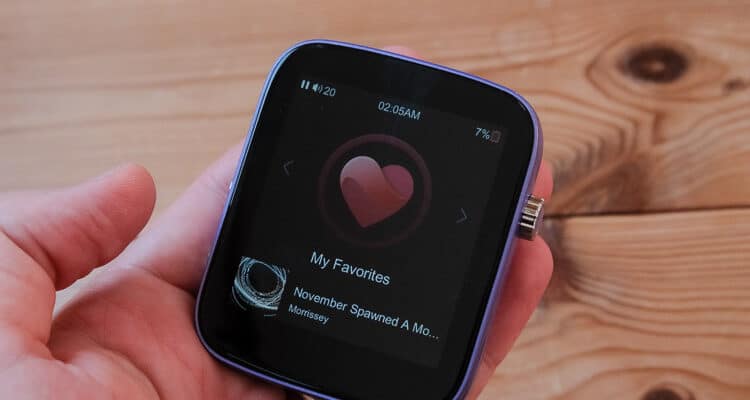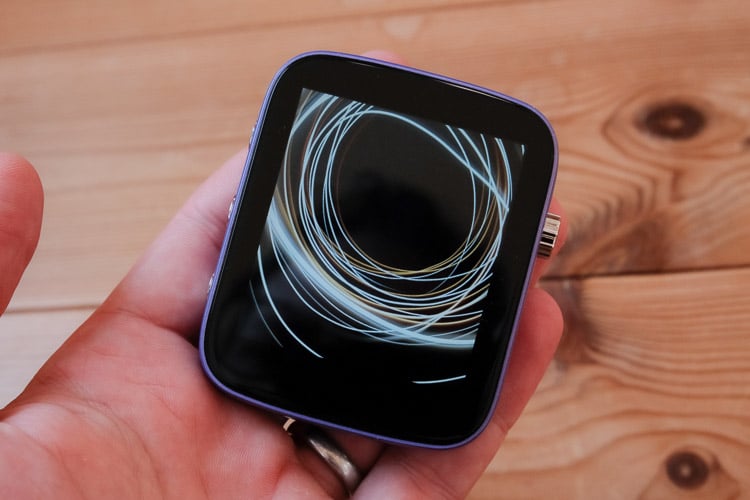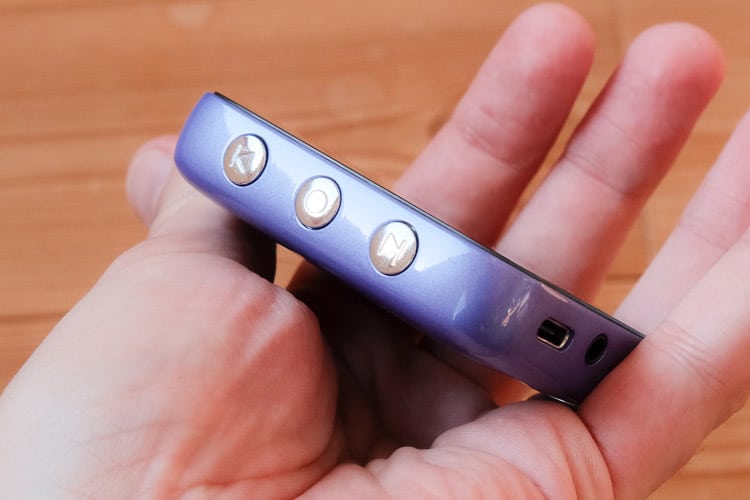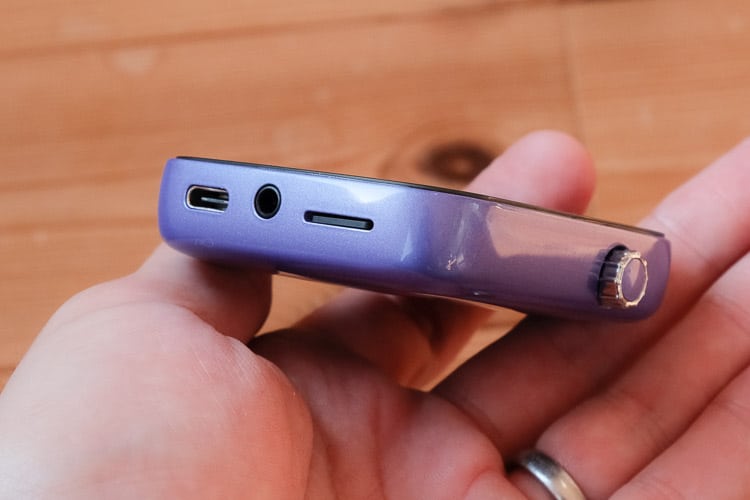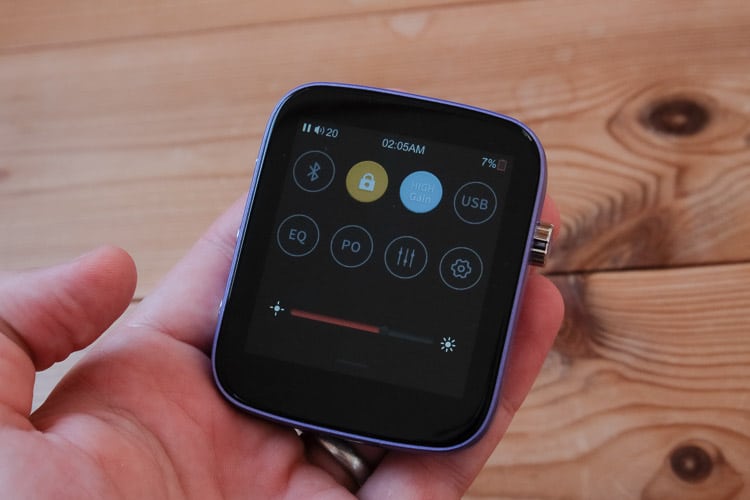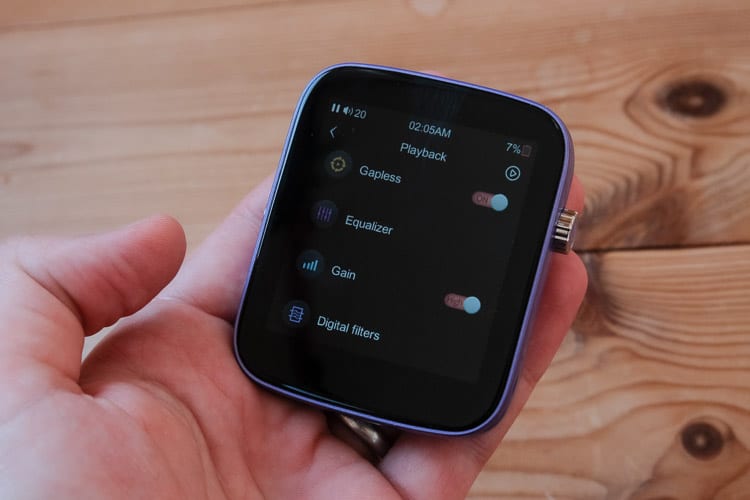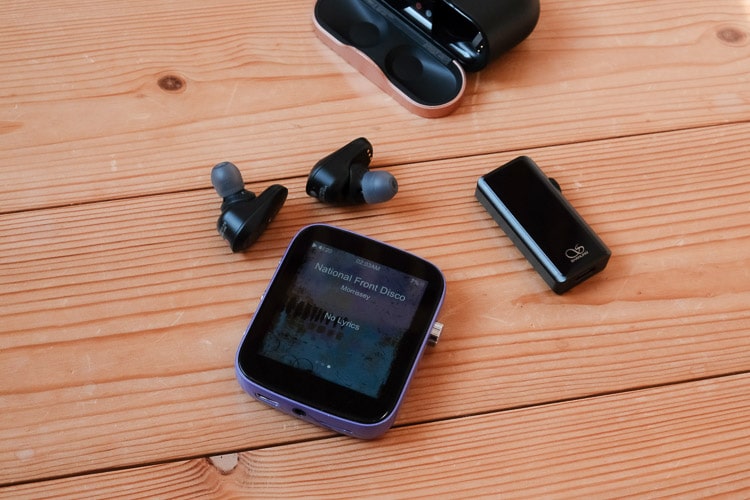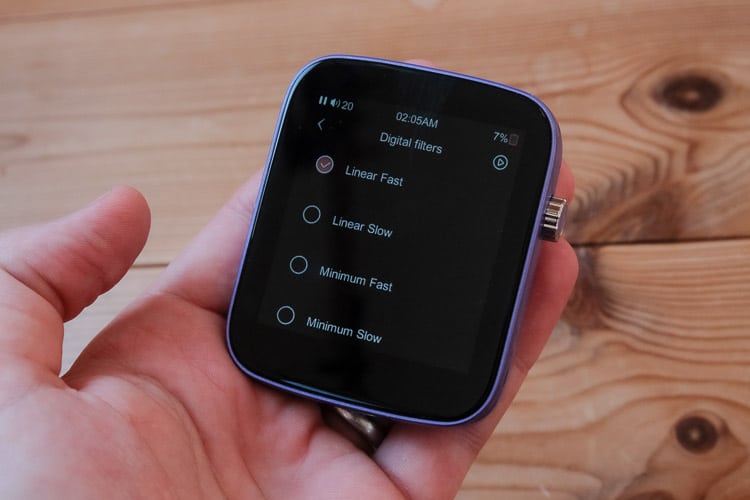The Shanling Q1 is a new Kickstarter-funded entry-level digital media player with a retro look inspired by the designs of the 1940s and 1950s. It is priced from $89.
Disclaimer: The Shanling Q1 sent to us is a sample in exchange for our honest opinion. We thank the team at Shanling for giving us this opportunity.
To read more about Shanling products we have reviewed on Headfonics click here. To access their Kickstarter campaign click here.
Note, this review follows our new scoring guidelines for 2020 which you can read up on here.
There aren’t a lot of cute DAPs out there. Cowon’s D2 ain’t cute. FiiO’s M6 ain’t cute. And while sexy, Shanling’s M2X ain’t cute. Heck, with every generation, even Apple’s iPod nano (God rest its soul) ‘bonered’ up what cuteness it had.
And while I don’t think Shanling reversed the trend with the Q1, they certainly have tried. Whether you find it cute or not, the Q1 is also the least Shanling-looking Shanling product I’ve tried. And maybe because of this – and the desire to circle the square – Shanling has also made one of the most usable DAPs I’ve tried in years.
Design
Because my unit is pre-production, it came with just a USB-C cable. I’ll leave it for the final Kickstarter owners to tell you what’s in the box and how it stacks up with the competition.
Attention to detail and brand flourishes aside, the Q1 is solid and easy to use. Glass fastens the screen up front, and metal wraps the sides and back into a tight, palm-sized package. Its buttons and attenuator are metal. Its USB, SD, and headphone ports are arrayed across the bottom, making it easy to slip into a trouser pocket.
The unit I have is pre-production, so I’ve not got much to say about finish quality except that I hope to see metal edges sanded down farther. Currently, they come up to the glass in rough, wave-like ripples.
When pressed, the screen moves in and out a bit spongily. The glass screen rises out slimly of the metal, bare and naked and unprotected. The metal edge should come flush to the screen and a bit of plastic or rubbers should shield it inside.
That said, the Q1 is solid, weighty, and feels great. If the final version improves on anything I’ve mentioned, the Q1 should be right up there with the best DAPs in its class. In fact, even if it doesn’t, the Q1 is wonderfully finished and fastened for an $89 player.
I’ve managed to scratch about 3mm from one painted corner and, considering that I’ve hardly treated the Q1 well, I think that is okay. It’s solid. It could be more solid. But at its price point, it actually stands out among much of the competition.
Screen
The Q1’s screen is tiny but easy to use. Colors are good and refresh rates more than acceptable; both exceed the pitiful efforts of Cowon’s Plenue D and D2 as well as Onkyo’s DP-S1. Scrolling is smooth, and while chinny, the Q1’s compact chassis never gets in the way of basic touch input and leaves just enough room at the sides and top/bottom to rest your thumb or finger without accidentally reading touch input.
Are the colors photo-accurate? No. They are a bit contrasty and bitey, but they look great, display album art really nicely, and the screen updates speedily. For a software interface almost wholly comprised of touch inputs, the screen is brilliant.
Controls
Even if you got clumsy fingers, the Q1 is duck soup to operate. Apart from the attenuator, each button is dedicated to a single function. The shiny button in the middle of the left-hand side pauses and plays music. The buttons on either side take care of tracking, up for tracking back, and down for tracking back.
As per usual, I have to complain about the inherent disconnect between up/back and down/forward as it relates to intuitive human interface, but, as the list is ordered downward, what are you supposed to do?
Selection of albums, songs, and other lists, as well as adjustments of DAC and EQ functionality, is done by touch. Because button and touch inputs aren’t mixed up, the Q1 is nigh impossible to mess up. And white not smartphone accurate, the touch controls are pretty tight. Dragging in the EQ sometimes catches, but overall, it is way better than the controls for the FiiO M6.
The Q1’s attenuator doubles as the mains switch. A long press turns it off or on. Large, thumb-friendly buttons ask if you really want to shut it down. A double pump will bring you out of the screen lock. My fingers aren’t nimble enough to make this process seamless, but yours may be.
Inputs & Outputs
The USB-C port sits on the bottom left. To the right of it sits the 3,5mm stereo output, to the right of which sits the damnable micro-SD slot. I can never get cards to go in on the first try and my metrosexual fingers can’t even grab them because they are so small. The Q1 situates that card face down, which, in my opinion, is backward. A card should be face up. That’s that.
Whatever; there is no way to fix the horror of the micro USB card without working a wide, countersunk mouth around it so that a push of a normal finger will put it in. Only a few DAPs out there nail micro SD card placement and installation niches.
In addition to ‘cuteness’, Shanling designed the Q1 for ‘economy’. Part of making an economical DAP is targeting it for the economical user. (I know a few, do you?) And, we economical users aren’t as likely as audio snobs to often use balanced.
Honestly, I use balanced most when reviewing gear- or when using a Sharp Auvi MD unit, whose terrible stereo image opens way up when plugging in a 3,5mm TRRS balanced cable. Therefore, I’ll not scoff at a player in the current year that doesn’t have a TRRS port somewhere and enough DACs to handle it all.
Storage
The Q1 lacks internal storage. I’ve been using 200GB Sandisk cards with it. I should mention that, after plugging it into a computer, the Q1’s USB firmware storage option is kind of tricksy. If you touch or handle the player much at all whilst plugged in it will easily unmount from your computer.
It’s not a physical connection issue, it is an issue of sensitivity. The disconnect button isn’t labeled. It is a small back-point arrow next to the plugged-in USB icon. It seems that it sucks in a lot of surrounding touch real estate, leaving a massive, exposed, and poorly labeled disconnect vortex just waiting to be touched.
Battery Life
Officially, the Q1 is good for up to 21 hours, depending on what the music you play is and how you play it. Like, do you chimp (use the screen?). Do you change albums a lot? Do you mix a lot of hi-res and low res stuff together?
Whatever your answers are, I’ve not gotten 21 hours out of it in any play mode or a mix of files. More than ten? Absolutely. Close to or exceeding 15? Probably. But 21? Maybe under some crossover of DAP and camera and using Fujifilm’s version of CIPA conditions, you could get 21 out of it.
Software
Q1’s iconography has come a long way. It started with cheap late-90s generic UI fluff and ended up with cheap 2000s-era generic UI fluff. I’m sure someone designed them, but they don’t look or feel like they belong in a DAP designed to diverge from typical Shanling UI, let alone something from after 2010. That said, the latest firmware and iconography is much improved.
As un-cute as its icons may be, the UI is brilliant. It is simple and the icons and basic navigation cues are large and easily thumb-able. A swipe up from the bottom takes you to the playback screen. A swipe down from the top brings up Bluetooth, lock screen, gain, USB, EQ, line/headphones out, DAC settings, and more.
Firmware files update easily from the settings menu and pop out of RAR containers in BIN files. Hit update and wham! Done in two minutes or so. The touch response speed is good and there is minimal tearing or other artifacts. As mentioned earlier, the screen is high-contrast with good colors. It washes out a bit at acute angles but is better than MUCH of the medium-priced competition from Cowon and Onkyo.
Scrolling speed is good, and when pulled or pushed to the extremes of a list, the momentum stops with natural, if abrupt weight. This makes it one of the best DAPs I’ve used for scrolling through a list.
Navigation
The playback screen sports a large play/pause button in the bottom middle and to either side, tracking forward and back. Playback mode is a small button above the scrobbling slider. That slider, which sits above the trackback button works well enough but is too close to the tracking and play/pause buttons, making it too easy to accidentally engage playback controls. Its feedback is also laggy.
Playback Performance
The Q1 blazes past DAPs like the Cowon Plenue D2 and Onkyo DP-S1 whose interfaces are achingly slow. It’s strange: I find that most cheap players keep their UIs running at a good clip. The reason may be this: most people that buy budget players are comparing their players to smartphones, and need things to stay as snappy as much as possible. And here the Q1 performs.
For one, gapless is very good, just not totally flawless. I’ve only had a couple of instances where it didn’t work properly, but again, it is better than most DAPs I’ve used.
It’s EQs and DAC settings are awesome. If you want, you can really screw things up with the EQ; and the seven digital filters you can choose from (Linear Fast, Linear Slow, Minimum Fast, Minimum Slow, Apodizing Fast 1, Apodizing Fast 2, Corrected min. Fast, and Brick wall, are comprehensive. My favorite among them is, as always, Linear Slow.
If the Q1 blazes through a simple GUI the way it does, why can’t other DAP makers do the same? Whatever. Way to go, Shanling.
Wireless
Oh, man is the Q1 good. You can use it to receive Bluetooth signals from your other phones or sources, and power your favorite headphones. I wish more Bluetooth devices had dual functionality. And considering how good the Q1 sounds, this is a powerful feature, especially if your source isn’t up to snuff.
It also throws pretty high-quality signals and for long distances. I can get almost 50 meters away from the Q1 when listening to my AirPods Pro, which is roughly in line with what I get when using an iPhone SE’s Bluetooth 4. Not top of the line, but nice.
Sound Impressions
Summary
So, the Q1 doesn’t measure as good as a Cowon Plenue D2 or Onkyo DP-S1 or a Shanling M2X. But that’s not exactly the fairest raft of comparisons, is it? It sounds great, slightly warm, and has loads of great stereo detail.
Also, it needs to be noted, that irrespective of the load, the Q1 spits absolute tip-top current to earphones and headphones. There are no dropouts anywhere, and stereo imaging is only mildly affected by harsh loads. That is if you are worried about bass or treble, or high midrange ‘suckout’, don’t. The Q1 nails both, all the time.
While not my current reference, the Q1 is more powerful than a medium to a high-end smartphone, and powers past Sony’s ZX300 and FiiO’s M6. Its signal shows good-to -great texture and it has good to great stereo detail. It pushes enough current into a vast array of headphones that it neither dips nor jumps in frequency. And, unless you’re using hungry planars with it, more likely than not, you’ll have to turn that volume down when listening to your large Beyers or Senns.
It hisses a bit more than a Cowon Plenue D2 or M2X, but not by much, meaning that you’ll be able to hook to it any manner of sensitive earphones and the outcome will be only the mildest of hiss noise.
Despite its power (measurements ceilings begin at -6dB rather than 0dB), the Q1 only barely hisses, making it a great but not perfect companion to earphones like Shure’s amazing SE846 and Ultrasone’s IQ. This, too, betters the FiiO M6 and certainly the M3, which hissed way too much for a dedicated DAP.
Timbre
I wish the Q1 was as warm sounding as the original FiiO X3. It isn’t, but it is mildly warm, and it sounds great with bright-ish earphones. As a result, the Q1 is pretty natural. And its signal is flat, from end to end. I’ve said earlier that usually, I find little difference between various DAPs. I still do, but subtle nuances leave some warmer, some crunchier, some boxier, and some more neutral.
The Q1 is warm-neutral, which basically plays to my preferences perfectly. Add a digital filter in there and you can warm it up a bit more, or almost do the opposite. Being middling wide, stereo warmth helps ground the listener within a well-defined stage.
Staging
The Q1 sets an admirable distance between stereo channels. No, it’s not as wide as something like the DP-S1 or Plenue D2, but it’s also not that far off at normal listening levels. As far as I’m concerned, the Q1 represents a good middle ground which presents good to great separation but doesn’t go too far and alienate the channels. Its slight warmth also helps draw out the Z-axis a bit, making for a great companion to comfy chair music, ballads, and the like.
Matchability
The Q1 isn’t as powerful as an AK380 or Plenue D2, or even a DP-S1. On high-gain it has more power than an iPhone 6, but not by a huge margin. That means that it will drive to pretty good volume a 600Ω DT880, HD650, and the like, and can even pack a punch with a bunch of planar headphones. But, it won’t drive those planars like a desktop system. Speaking of, the Q1 does have a more powerful amp than my Lynx HILO.
But because it also doesn’t hiss much, and has gain control, it is great for sensitive earphones as well. It is bettered at both extremes by a number of DAPs on the market, but none commensurate to the differences in price. Basically plug in 95% of sensitive earphones out there and you will get on. Ditto for portable headphones. And you can probably lower that number to 90% for full-size headphones.
Select Comparisons
Shanling M2X
The Q1’s older brother looks and performs markedly up class. Its balanced really holds well against players much more expensive than it, but neither does it reach for the stars. It is not quite as warm as the Q1, but sports a nice UI, and is handsome to boot. It is hard to imagine that the two are siblings, but they are both incredible players which I recommend heartily at their respective price points.
FiiO M6
Hands-down, the Shanling is better. It measures better, is more powerful, hisses less, and has a GUI which is easier to use for fingers of all sizes. I think it sounds better, but if you prefer a cooler sound, the M6 might do you.
Our Verdict
The Q1 is feature-packed at any price. Catching downstream Bluetooth signals so you can use your favorite headphones or earphones on the sofa whilst listening to music from your TV or even patching the connection from a smartphone is completely awesome. I wish more DAPs had this functionality.
I love the Q1’s big buttons, easy to use GUI and hardware interface, nice screen, solid body, and quality sound. It is a LOT of player for not a lot of money and it impresses me way more than anything in the price range I’ve tried from FiiO. If you weren’t already paying attention to Shanling you should now.
I dislike how the SD card goes in, the icons and a few other things, but overall, I think the Q1 is a great buy.
Q1 Specifications
- Screen: 2,7 inch 360×400 touch screen
- System: Touch OS by Shanling
- Weight: 136,8g
- DAC: ESS Sabre E9218P
- Battery life: up to 21 hours (depending on usage)
- Deep standby: up to 20 days (depending on usage)
- Charging time: 2 hours (depending on usage)
- Battery capacity: 1100 may
- Storage: up to 2TB micro SD card
- Audio formats: APE, FLAC, ALAC, WMA, AAC, OGG, MP3, OPUS, WAVE, AIFF, DSF, DIFF
- Output port: 3,5mm jack headphone output
- Output Power: 80mW @32Ω, Output impedance: <0,2Ω
- Channel separation: -78dB
- Recommended headphone impedance: 8-300Ω
- Frequency response: 20-40kHz
- Distortion: 0,004%
- Signal to noise Ratio: 118dB
- Ground noise: <3,2uV (High Gain) <1,5uV (Low Gain)
- Dynamic Range: > 105dB
- Hi-Res support: up to 384kHz / 32bit, DSD64 & DSD125
- Bluetooth: Two-way Bluetooth 4,2
- Bluetooth Codec: Two-way LDAC, AAC, SBC, Transmit only aptX




